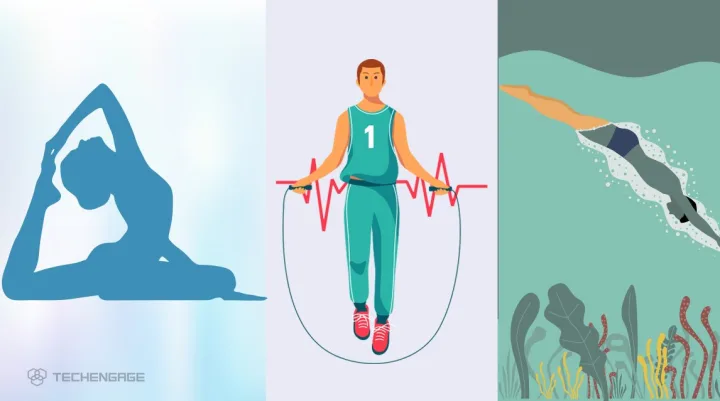High blood pressure is a medical problem that increases the pressure of blood in our arteries which negatively affects our heart. It also makes the circulation of the blood through the vessels harder.
High Blood pressure is also known as hypertension. It is not a disease, but it may cause and lead to coronary heart disease, stroke, congestive heart failure, renal failure, and peripheral vascular disease. So, it should not be ignored, and therefore it is necessary to have control over it. We may call it a silent killer with no warning symptoms.
Best way to lower your blood pressure
Exercise is a drug-free way to reduce your high blood pressure and is the best remedy around. It costs almost nothing. There are many types of exercises, but physical exercises are best at lowering blood pressure.
Regular exercise constitutes an everyday aerobic activity that makes your heart stronger.
Aerobic activities include household chores such as cleaning the floor, raking leaves, mowing the lawn, walking, jogging, bicycling, swimming, dancing, etc.
A strong heart is the one that can pump the blood with less effort, so the force on the arteries decreases resulting in lowering our blood pressure.
How does exercise help?
Exercise has many benefits apart from reducing blood pressure. Epidemiological studies tell that aerobic activities are beneficial for both the prevention and treatment of high blood pressure. If a person is more active, they have fewer chances of having high BP.
The first thing exercise does stimulate our heart to circulate oxygen rich-blood through our arteries. It allows the blood to pass through easily. A single workout can reduce blood pressure for the whole day, and regular exercise can keep the blood pressure down.
Also, ever heard about Artificial blood? It is actually a substitute for biological blood.
Exercise reduces weight as well as the risk of diseases. There are the chances of high blood pressure increase with age but doing regular exercise can bring a huge difference. People who already have high blood pressure can exercise to control it as well.
Yoga
As stress can also cause, high BP, stretching and breathing exercises may have a calming effect that helps reduce stress. Further, it also helps in maintaining weight. If one wants to manage blood pressure through yoga, the most common practices advised include mindfulness medication, alternate nostril breathing, and easy pose.
Swimming
An American study published in the Journal of Cardiology found out that if a person (60-year-old) swims 3-4 times per week in 12 weeks, his systolic pressure can be reduced to nine points on average.
Stretching
This will help to increase flexibility which we lose as we get old. Stretching increases mobility which helps one to keep moving. The less sedentary the person is, the better it is for their heart and blood pressure.
Resistance training
This exercise may also be useful for reducing high BP for a long run even though it may lead to high blood pressure during execution. This exercise is good for a person who sits several hours a day.
Walking
Walking can be the best exercise to control high blood pressure as it is incredibly accessible. In one study, the researcher found out that the amount of energy a person uses for moderate intensity vigorous running and energetic walking would result in the reduction of high blood pressure and cholesterol.
Isometric hand-grip
This exercise may help to lower BP by improving the function of the blood vessels and making it flexible. This can be expensive if the grips used are advanced, but it tends to be much safer to do as compared to other types of resistance training.
Things that may increase blood pressure
Unhealthy lifestyle such as lack of aerobic activities/physical exercises and poor diet can lead to weight problems and increase in weight may then result in increasing the risk of boosting blood pressure. It can be genetic. Stress and older age can also be the reasons for high blood pressure.
How much exercise is required to reduce blood pressure?
Exercise plays a vital role in managing high blood pressure, but it should be done wisely. It is a tool along with a medication to keep blood pressure to its normal range and reduce the risk of multiple diseases.
Department of Health and human services suggest an adult have 150 minutes of moderate aerobic activity in a week and also indicates that a person who sits several hours a day should reduce his/her time of sitting. If the person has not exercised lately, they should take baby steps towards a complete workout. Warm up by walking slowly or stretching for 5 minutes then exercise for 25-30 minutes and cool down with five minutes of light work. One should not lift the weights if their blood pressure is not controlled.
Many treatments for high blood pressure may have unpleasant side effects, but exercise is one exception. Regular exercise may result in reducing your medication to control blood pressure. If one exercise regularly then they can see the results in a few months.
Tips for exercising
One should exercise properly. Don’t overdo the exercises, start with little exercise and then increase the time and intensity of physical exercises as you progress. If one feels chest pain or pressure, they should stop the activity right away.
One may also consult their primary care physician before starting any stretching exercises. A man older than 45 and women older than 55 should check with their doctor before beginning an exercise program.
Conclusion
Regular exercise in several forms can help a lot in achieving controlling high blood pressure. It is a beneficial and better approach towards a healthy lifestyle. It gives the best advantage of reducing the risks of so many illnesses, which arise as a consequence of high blood pressure.
Inspired by: Everyday Health




I do regular exercise, try decreasing my anxiety,
and lessened the sugar quantity, and now my blood
pressure has lowered and I am getting normal.